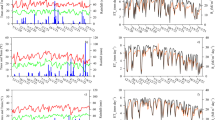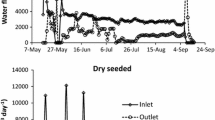Abstract
The evapotranspiration (ETc) of sprinkler-irrigated rice was determined for the semiarid conditions of NE Spain during 2001, 2002 and 2003. The surface renewal method, after calibration against the eddy covariance method, was used to obtain values of sensible heat flux (H) from high-frequency temperature readings. Latent heat flux values were obtained by solving the energy balance equation. Finally, lysimeter measurements were used to validate the evapotranspiration values obtained with the surface renewal method. Seasonal rice evapotranspiration was about 750–800 mm. Average daily ETc for mid-season (from 90 to 130 days after sowing) was 5.1, 4.5 and 6.1 mm day−1 for 2001, 2002 and 2003, respectively. The experimental weekly crop coefficients fluctuated in the range of 0.83–1.20 for 2001, 0.81–1.03 for 2002 and 0.84–1.15 for 2003. The total growing season was about 150–160 days. In average, the crop coefficients for the initial (Kcini), mid-season (Kcmid) and late-season stages (Kcend) were 0.92, 1.06 and 1.03, respectively, the length of these stages being about 55, 45 and 25 days, respectively.








Similar content being viewed by others
References
Aguilar M, Borjas F (2005) Water use in three rice flooding management systems under Mediterranean climatic conditions. Span J Agric Res 3:344–351
Alberto MCR, Wassmann R, Hirano T, Miyata A, Kumar A, Padre A, Amante M (2009) CO2/heat flux in rice fields: comparative assessment of flooded and non-flooded fields in the Philippines. Agric For Meteorol 149:1737–1750
Alberto MCR, Wassmann R, Hirano T, Miyata A, Hatano R, Kumar A, Padre A, Amante M (2011) Comparisons of energy balance and evapotranspiration between flooded and aerobic rice fields in the Philippines. Agric Water Manage 98(9):1417–1430
Allen RG, Pruitt WO, Businger JA, Fritschen LJ, Jensen ME, Quinn FH (1996) Evaporation and transpiration. In: Heggern RJ, Wootton TP, Cecilio CB, Fowler LC, Hui SL (eds) Hydrology handbook, 2nd edn. American Society of Civil Engineers, New York, pp 125–252
Allen RG, Pereira LS, Raes D, Smith M (1998) Crop evapotranspiration: guidelines for computing crop water requirements, FAO irrigation and drainage paper no. 56. FAO, Rome
Attarod P, Aoki M, Komori D, Ishida T, Fukumura K, Boonyawat S, Tongdeenok P, Yokoya M, Punkngum S, Pakoktom T (2006) Estimation of crop coefficients and evapotranspiration by meteorological parameters in a rain-fed paddy rice field, cassava and teak plantations in Thailand. J Agric Meteorol 62:93–102
Cavero J, Medina E, Puig M, Martínez-Cob A (2009) Sprinkler irrigation changes maize canopy microclimate and crop water status, transpiration and temperature. Agron J 101(4):854–864
Chahal GBS, Sood A, Jalota SK, Choudhury BU, Sharma PK (2007) Yield, evapotranspiration and water productivity of rice (Oryza sativa L.)-wheat (Triticun aestivum L.) system in Punjab (India) as influenced by transplanting date of rice and weather parameters. Agric Water Manage 88:14–22
De Datta SK (1981) Principles and practices of rice production. Los Baños (Phillippines). International Rice Research Institute, pp 618
Doorenbos J, Pruitt WO (1977) Crop water requirements. FAO irrigation and drainage paper no. 24. FAO, Rome
FAO (2009) Food and agriculture organization of United Nations. Statistical data base, FAOSTAT, Available http://faostat.fao.org. Data retrieved on 1 June, 2011
Franssen HJH, Stöckli R, Lehner I, Rotenberg E, Seneviratne SI (2010) Energy balance closure of eddy-covariance data: A multisite analysis for European FLUXNET stations. Agric For Meteorol 150:1553–1567
Gutiérrez Elorza M, Gutiérrez Santolalla F (1998) Geomorphology of the Tertiary gypsum formations in the Ebro Depression (Spain). Geomorphology 87:1–29
Ham JM (2005) Useful Equations and Tables in Micrometeorology. In: Viney MK, Hatfield JL, Baker JM (eds) Micrometeorology in agricultural systems. Agronomy Series No. 47. American Society of Agronomy, Crop Science of America, Soil Science Society of America, Madison, pp 533–560
MARM (2009) Anuario de Estadística 2009. Ministerio de Medio Ambiente Medio Rural y Marino. Available: http://www.marm.es/es/estadistica/temas/anuario-de-estadistica/2009. Data retrieved on 30 June, 2011
Martínez-Cob A (2001) Adequacy of Villalobos method to adjust eddy covariance latent heat flux. Irrig Sci 20:175–188
Martínez-Cob A, Playán E, Zapata N, Cavero J, Medina ET, Puig M (2008) Contribution of evapotranspiration reduction during sprinkler irrigation to application efficiency. J Irrig Drainage Eng-ASCE 134(6):745–756
Mengistu MG, Savage MJ (2010) Surface renewal method for estimating sensible flux. Water SA 1:9–18
Moratiel R, Martínez-Cob A (2011) Evapotranspiration of table grape trained to a gable trellis system under netting and black plastic mulching. Irrig Sci. doi: 10.007/s00271-011-0275-3
Paw UKT, Qiu J, Su HB, Watanabe T, Brunet Y (1995) Surface renewal analysis: a new method to obtain scalar fluxes without velocity data. Agric For Meteorol 74:119–137
Paw UKT, Snyder RL, Spano D, Su HB (2005) Surface renewal estimates of scalar exchange. In: Hatfield JL, Baker JM, Viney MK (eds) Micrometeorology in agricultural systems. Agronomy Monograph No. 47. American Society of Agronomy, Crop Science Society of America, Soil Science Society of America, Madison, pp 455–483
Potter E, Wood J, Nicholl C (1996) SunScan canopy analysis system: user manual. Document SS1-UM-1.05. Delta-T Devices Ltd, Cambridge
Seung Hwan Y, Jin-Yong C, Min Won J (2006) Estimation of paddy rice crop coefficients for Penman-Monteith and FAO modified Penman method. ASABE Annual International Meeting, Oregon
Snyder RL, Spano D, KT PawU (1996) Surface renewal analysis for a sensible and latent heat flux density. Bound-Layer Meteor 77:249–266
Spano D, Snyder RL, Duce P, KT PawU (1997) Surface renewal analysis for sensible heat flux density using structure functions. Agric For Meteorol 86:259–271
Spano D, Snyder RL, Duce P, KT PawU (2000) Estimating sensible and latent heat flux densities from grapevine canopies using surface renewal. Agric For Meteorol 104:171–183
Spanu A, Murtas A, Ballone F (2009) Water use and crop coefficients in sprinkler irrigated rice. Ital J Agron 2:47–58
Tabbal DF, Bouman BAM, Bhuiyan SI, Sibayan EB, Sattar MA (2002) On-farm strategies for reducing water input in irrigated rice; case studies in the Philippines. Agric Water Manage 56:93–112
Testi L, Villalobos FJ, Orgaz F, Fereres E (2006) Water requirements of olive orchards. I Simulation of daily evapotranspiration for scenario analysis. Irrig Sci 24:69–76
Twine TE, Kustas WP, Norman JM, Cook DR, Houser PR, Meyers TP, Prueger JH, Starks PJ, Wesely ML (2000) Correcting eddy-covariance flux underestimates over a grassland. Agric For Meteorol 103:279–300
Tyagi NK, Sharma DK, Luthra SK (2000) Determination of evapotranspiration and crop coefficients of rice and sunflower with lysimeter. Agric Water Manage 45:41–54
Willmott CJ (1982) Some comments on the evaluation of model performance. Bull Am Meteorol Soc 63:1309–1313
Wilson K, Goldstein A, Falge E, Aubinet M, Baldocchi D, Berbigier P, Bernhofer C, Ceulemans R, Dolman H, Field C, Grelle A, Ibrom A, Law BE, Kowalski A, Meyers T, Moncrieff J, Monson R, Oechel W, Tenhunen J, Valentini R, Verma S (2002) Energy balance closure at FLUXNET sites. Agric For Meteorol 113:223–243
Xue C, Yang X, Bouman BAM, Deng W, Zhang Q, Yan W, Zhang T, Rouzi A, Wang H (2008) Optimizing yield, water requirements, and water productivity of aerobic rice for the North China Plain. Irrig Sci 26:459–474
Zapata N, Martínez-Cob A (2002) Evaluation of the surface renewal method to estimate wheat evapotranspiration. Agric Water Manage 55(2):141–157
Acknowledgments
This work was funded through project AGL-2000-1775-C03-02 (Plan Nacional de I+D, Spanish Ministry of Science and Technology). Thanks are due to Dr. P.J. Pérez for lending the eddy covariance system, J. Cavero and O. Pérez for technical assistance, and M. Izquierdo, J. Gaudó, E. Mayoral and I. Clavería for field assistance. We greatly appreciate the assistance of Dr. Richard H. Cuenca to edit for the correct use of the English language.
Author information
Authors and Affiliations
Corresponding author
Additional information
Communicated by J. Kijne.
Rights and permissions
About this article
Cite this article
Moratiel, R., Martínez-Cob, A. Evapotranspiration and crop coefficients of rice (Oryza sativa L.) under sprinkler irrigation in a semiarid climate determined by the surface renewal method. Irrig Sci 31, 411–422 (2013). https://doi.org/10.1007/s00271-011-0319-8
Received:
Accepted:
Published:
Issue Date:
DOI: https://doi.org/10.1007/s00271-011-0319-8




